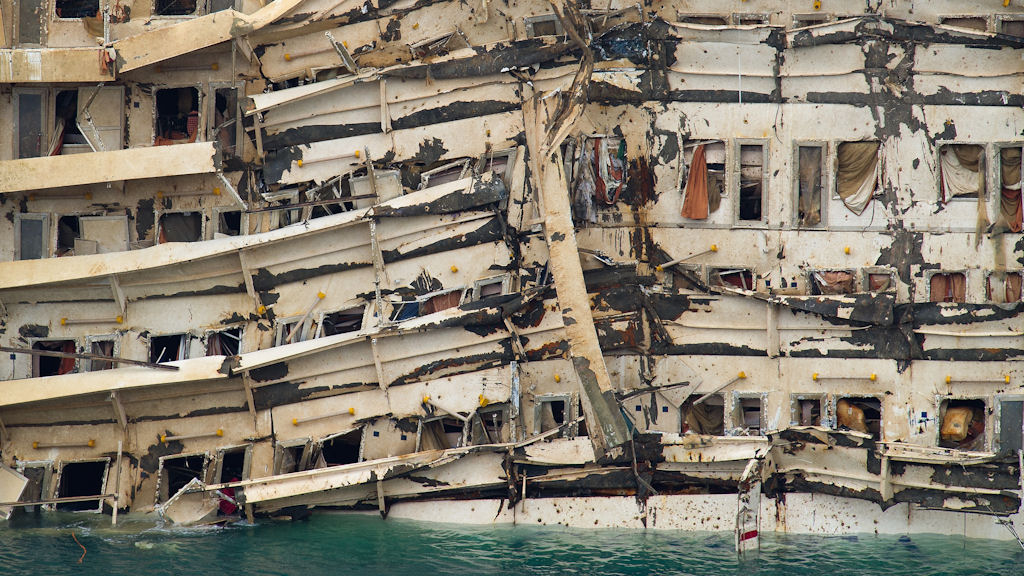What next for the Costa Concordia?
It took more than 500 people, millions of euros and months of work to right the sunken cruise ship, the Costa Concordia. But it ain’t over yet…
After a marathon 19-hour effort, the vast Costa Concordia cruise ship has been pulled upright off the coast of the Italian island of Giglio.
The 114,000-ton ship sank more than 18 months ago, killing 32 people, and has remained listing on its side and looming over the island ever since.
The operation to right her was the biggest of its kind ever, and engineers and experts are thrilled by the success of the “parbuckling” process. But it is not over yet – many more months of work, plus piles of euros, will be required to clean up after the disaster.
Mark Hoddinott, general manager of the International Salvage Union, used to work for the company which is undertaking the salvage operation on the stricken cruise ship.
He told Channel 4 News it was “incredible” how smoothly the operation had gone so far – but pointed out that a number of challenges lie ahead.
First, salvors will undertake a thorough survey of the starboard side of the ship, which has been lying against the reef, and check for damage above and below water, with divers.
[Still inside the ship] there will be a lot of perishables, all the rotting food, all the furnishings, fittings. Mark Hoddinott, International Salvage Union
Then they will attach caissons – the boxes already attached to the port side – to help her float at a later date.
“There is no flat area, so there will be some fabrication to be done before this can happen – some building, welding, steelwork,” said Mr Hoddinott.
The caissons on the port side are currently filled up with water and helped bring the ship upright. When the time comes to refloat the Costa Concordia, the water will be pumped out to provide buoyancy to lift the ship.
Watch below: a time lapse video of the righting of the Costa Concordia.
Mr Hoddinott does not expect a problem with refloating the Costa Concordia, pointing out that the operation would be unlikely to have reached this stage if the salvors thought she was too damaged to float.
If the experts had thought it was not feasible to move her, in line with other wrecks, they would have removed all the pollutants, such as the fuel – which was done very early on with the Costa Concordia for environmental and safety reasons – then left her.
The Italian authorities insisted that the ship was moved away in one piece for environmental reasons, which is why the next step will be getting the ship afloat and then towing the huge vessel away – with either a very large tug boat, or, more likely, several.
There is no question of repair: instead the Costa Concordia will be towed to a facility where she can be broken up and smelted down to be recycled and re-used.
Read more: Costa Concordia captain says 'sorry'
The closest port with any sizeable ship breaking business is Turkey, but that is a fair distance to tow a giant, badly-damaged ship.
“I can imagine they will try and avoid that,” said Mr Hoddinott, who expects instead facilities to be either brought to an Italian port or indeed built with the purpose of breaking up the Costa Concordia – a task which does not sound cheap.
“It’s fairly well-known that the insurers of the ship have made a provision for something over $1bn,” he said.
“And by the way, this is all going to take quite a while. I would be surprised if they move the ship before next year – I imagine they will aim for spring time. Once she’s afloat there’s no putting her back,” he said.

The trickier issues with getting the Costa Concordia up and away lie inside her hull – chiefly, the water she took on when she sank, and the items which had to be abandoned when the passengers and crew fled the ship.
“There’s a huge disposal problem. [What’s still in there] will be a lot of perishables, all the rotting food, all the furnishings and fittings,” said Mr Hoddinott.
“When they come to pump the water out from inside, it will be such a mess.”
He expects this process to take place wherever they break up the ship, in a proper facility, because it will have to be carefully controlled – the rotting goods will have released noxious fumes such as hydrogen sulphide which could be quite dangerous.
When they come to pump the water out from inside, it will be such a mess. Mark Hoddinott
“The water inside could also be fairly foul – it can’t just be pumped over the side. It will have to be pumped into barges and then taken away and disposed of properly and filtered,” said Mr Hoddinott.
However, he expects the process to go smoothly as the initial challenging stages have been so well handled. In fact, while the disaster itself and the immediate rescue response have drawn condemnation and even criminal trials, Mr Hoddinott said the lack of any major environmental damage in the 20 months the cruise ship has been beached was a major credit to Costa Cruises, the owner of the vessel, and its wider disaster recovery team.
“It’s incredible how smoothly this has gone. I’ve been in salvage for over 30 years and you move from Plan A to B to Z in quick order. They’ve gone into this knowing there was only one chance.
“It’s never been done before – this is the biggest operation of its kind.”